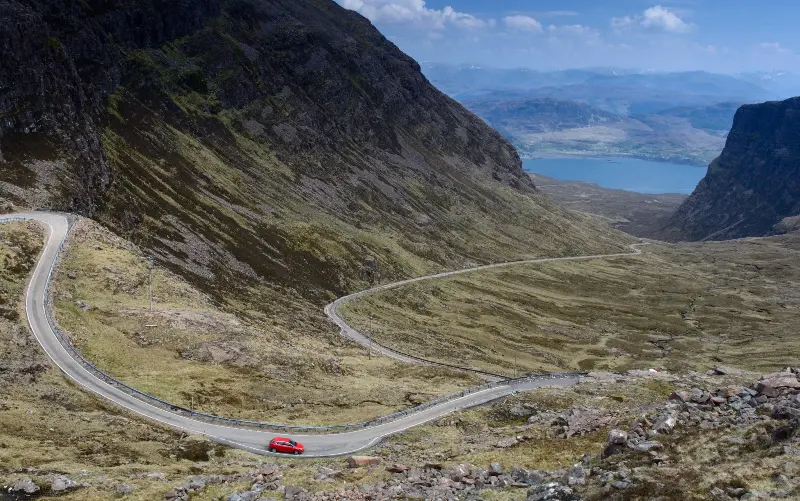
At the foot of Bealach na Bà in the Scottish Highlands, you receive a stark warning.
“This road rises to a height of 2,053ft, with gradients of one in five and hairpin bends,” a big blue sign reads. It is raised high up above the side of the road so people can no longer slap their touring stickers on it.
The warnings continue. Learner drivers, very large vehicles and caravans should turn away and take the more leisurely 7.5-mile coastal route instead. It is the sign equivalent of a reassuring hand on the shoulder, saying: “There’s still time to change your mind.”
Which, of course, I ignored. Like thousands of drivers every year, I had travelled some distance to tackle Britain’s most spectacular road ascent, with switchbacks and sweeping views reminiscent of the great Alpine passes. I wasn’t turning around now.
A road designed for cows (not cars)
Things got off to a bad start.
“You need to wait at the fudging passing place,” the red-faced Scot growled out of his window (I paraphrase).
He was completely right, of course. I was trying to turn off my rental car’s auto-steer mechanism, which couldn’t comprehend single-track roads, and hadn’t noticed the little white car zooming towards me. The result was a very tight squeeze and a tyre or two in a ditch.
For hundreds of years, the notion of traffic on this road was unthinkable. One of the first to traverse this mountain was St Máel Ruba, a 7th-century Irish monk who set up a monastic community in Applecross. For centuries it was used as a drovers’ path (Bealach na Bà translates as “pass of the cattle”); only later did it become a road suitable for cars.
The most recent switchback in the history of Bealach na Bà (also commonly called the Applecross Pass) came in 2015, when it was included on the map for a new tourism initiative called the North Coast 500. For many people it is the highlight of the 516-mile tour. Almost overnight, a pass first used by monks, then cows, then villagers, and perhaps the occasional passing tourist, became part of a road trip enjoyed by many thousands of tourists every year. Cycling sportive events, caravanners and Jeremy Clarkson soon followed.
I offered my apologies, dropped down the gears and began my ascent. And after turning the first corner, with the spaghetti-thin road coiling before me, the Yosemite sandstone cliffs casting deep shadows on the pass, it dawned on me that this is anything but a playground. Bealach na Bà may be one of Britain’s most spectacular roads, but it’s also one of its most dangerous.
Sweeping views and scissor-sharp switchbacks
In the early stages of the ascent there is grassy moorland to the left of the road, but soon the drop becomes so steep that a rail appears to buffer wayward drivers from a certain tumble to oblivion. The drive is thrilling, but requires focus. On the Applecross Pass, as with all single-track roads in the Highlands, your eyes are fixed hundreds of yards ahead to anticipate pulling in at a passing place, which I had to do on a few occasions.
After overtaking a lone cyclist, who creaked along at approximately 3mph, the hairpin bends began: three scissor-sharp turns that demanded a drop into first gear and a heavy rev of the accelerator. Shortly after the third switchback was a little lay-by, where I paused for a moment to take in the scale of this cavernous valley.
Here I met a chap called Josh from Iowa, who had the same idea. He was steering a drone above the mountain pass. I asked how he was finding the drive.
“Your roads over here are so incredibly small,” he said, fiddling his thumbs as he spoke. “Even when there are two lanes, when I’m driving my rental car I feel like I’m sucking my gut in. Got a tour bus on one side and a stone wall on the other. But there’s nothing to beat it for beauty.”
At the next stopping point, the summit, I found a bigger car park surrounded by dozens of dinky rock piles left by the many tourists who had been here before me. The south-westerly view was crystal clear, reaching all the way to the flat-topped island of Eigg and the volcanic pinnacles of Rùm.
A road sign pole was slapped with stickers. “Northern Bikers on Tour”, “Wirral Porsche Enthusiasts” and the obligatory “Nett Hier” sticker, among others. To the untrained eye, you might think the tourists have fully conquered this pass. But then I heard a rumble on the road. A Tesco delivery van whizzed by, shortly followed by a JCB digger in the opposite direction. A reminder that, while people like myself enjoy the transitory thrills of this pass, it remains a vital road for an entire community.
Trouble in paradise
The second half of the Applecross Pass was more gradual, with the North Sea and Skye unravelling before me. Up here the red, brackish, treeless landscape feels Martian, with only the occasional electric blue pools confirming that you are, indeed, on Planet Earth.
While maps call the waterfront village at the end of the pass “Applecross”, locals simply refer to the village as “the street”. There is a pleasing edge-of-the-world quality to the place, and for most of its history the sense of isolation was quite real. Until 1975, when the coastal road via Shieldaig opened, snowfall or ice on Bealach na Bà would render it impossible to get in or out by road.
Fortunately snow wasn’t a risk on my visit, so I popped into the Applecross Inn for a celebratory (non-alcoholic) beer. I asked the owner, Judith Fish, how things have changed since the launch of the North Coast 500.
“There are some snarl-ups on there with the bigger motorhomes coming head to head, and in the passing places it can be tight with two cars. Often, somebody has to reverse. We see approximately five punctures a week up there, minimum, because people pull off the edge and cut the inside of their tyres,” she said, and I winced at the thought of my own earlier encounter.
“There’s a lot more rallies, and that’s what aggravates the people living here because they block the road. People don’t live here for that sort of thing,” she added, noting that I had chosen a quiet day to tackle the road (a Thursday outside of the school holidays in April).
“A lot of older people are frightened now of driving over the mountain, and you’ve got to give yourself double the time to get where you’re going. That could be for doctors appointments, injections, breast screenings. You also get a lot of road rage on the mountain,” she said.
There have been other shifts since Bealach na Bà rose to international prominence. Guests at the Applecross Inn tend to stop over for just one night now before darting off to complete the North Coast 500, rather than staying for longer and enjoying the wider sights across the peninsula. There was also a spot at the head of the bay where people used to camp and swim, but that’s now been blocked off with big boulders after local rangers found as many as 15 fire patches in a single morning during the post-Covid staycation boom.
Judith Fish looked out across the bay and nodded towards the land on the other side.
“At times I look across the bay there and wish there was a Nando’s and a Wetherspoons. Maybe a Chinese restaurant,” she laughed, but I sensed she was only half joking. “At least then we’d get our village back.”
How to do it
The Applecross Pass is best tackled in the shoulder seasons of spring or early autumn, outside of the peak summer months and the school holidays. If you tackle it in high season, you face a high likelihood of meeting lots of other traffic on the road. The road is often impassable in the winter months due to snowfall or icy conditions.
What to see and do
The Walled Garden of Applecross House is a lovely spot for a stroll, and you can pick up a coffee or lunch in the cafe. The Applecross Heritage Centre (£3) covers the history of the peninsula, dating back to Mesolithic activity 8,000 years ago. In the village you will find a few gift shops and galleries, plus a store and post office.
Where to stay
With only seven rooms, the Applecross Inn gets booked up many months in advance. If it’s your thing, there’s an excellent campsite in the village. A little further afield, the Plockton Inn (doubles from £129 in low season) is a cheery, comfortable 19th-century hotel on the sheltered shores of Loch Carron. The menu here is full of local catches – langoustines, oysters, steamed clams and mussels – and if you’re lucky, you may catch a wee music session in the bar area.
